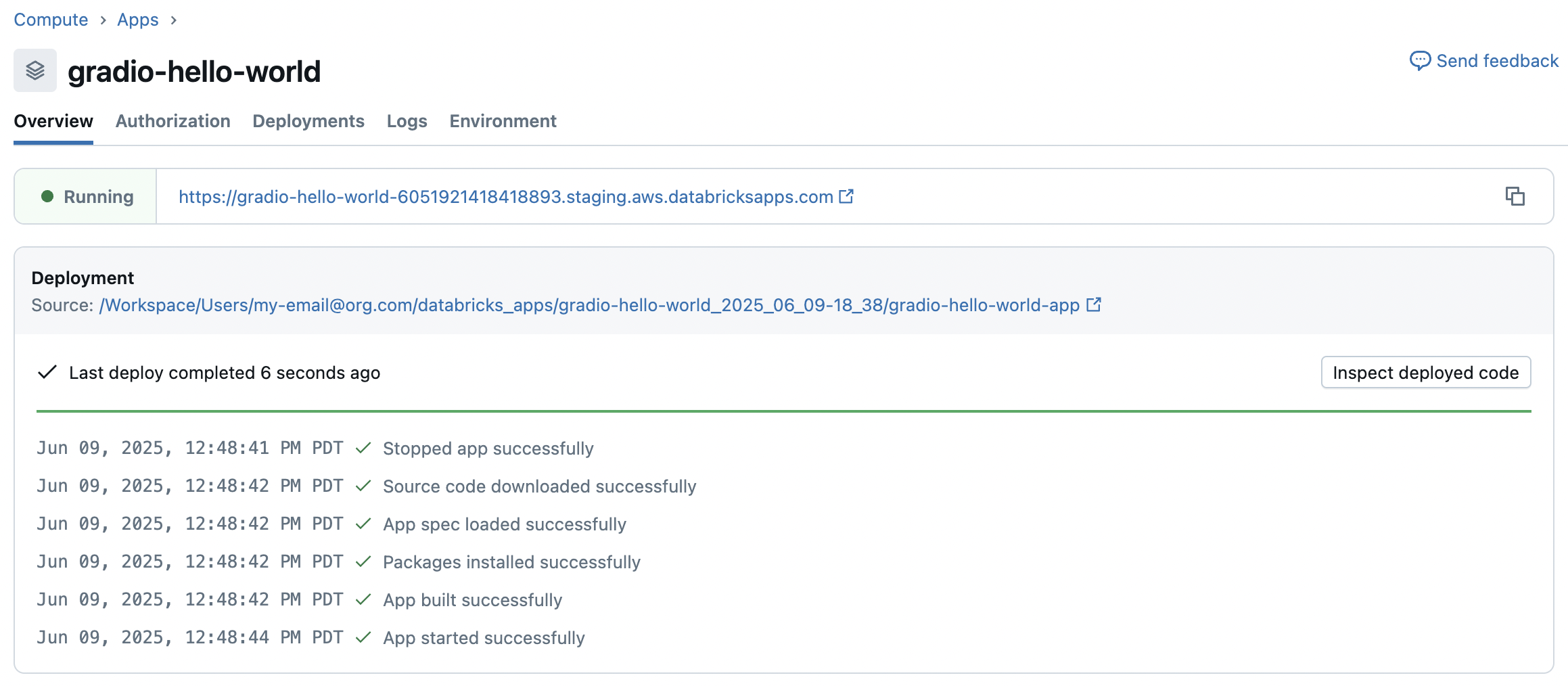Deploy a Databricks app
After you create and develop your Databricks app, deploy it to make it accessible in the Databricks workspace. Deployment builds your app, installs dependencies, and runs it using the configuration defined in your project files. You can deploy apps using the Databricks UI or the Databricks CLI.
If you create an app from a template, Databricks deploys it automatically when you first create it. However, you can still re-deploy it later after you make changes. See Create a Databricks app from a template.
Deployment logic
Databricks Apps supports deploying applications that use either Python, Node.js, or a combination of both. This allows for flexible architectures, such as a Node.js frontend with a Python backend.
During deployment, the build process checks for a package.json file at the root of your app directory to determine whether Node.js is used. If present, it includes Node-specific build steps alongside Python steps. The deployment logic follows this pattern:
If package.json is present:
- Run
npm install - Run
pip install -r requirements.txt(if it exists) - Run
npm run build(if abuildscript is defined inpackage.json) - Run the command specified in
app.yaml, ornpm run startif no command is specified
If no command is specified in app.yaml, Databricks executes npm run start, even if the app includes Python code. To run both Python and Node.js processes, define a custom start script that uses a tool like concurrently to launch both. For example: concurrently "npm run start:node" "python my_app.py".
If package.json is not present:
- Run
pip install -r requirements.txt(if it exists) - Run the command specified in
app.yaml, orpython <my-app>.pyif no command is specified
Prepare for deployment
Before you deploy your app, verify that your project includes the necessary components:
- Main script - Your entry point file, such as
app.pyorapp.js. - Optional
app.yamlfile - If your app requires a custom command or environment variables, include anapp.yamlfile to configure execution. See Configure Databricks app execution withapp.yaml. - Dependencies - Make sure all dependencies are available. See Manage dependencies for a Databricks app.
- Secrets or environment values - If you use the
envsection inapp.yaml, verify that the referenced secrets or external sources are correctly configured and accessible. See Add resources to a Databricks app.
In addition, make sure the app service principal has access to the source code folder.
Deploy the app
- Databricks UI
- Databricks CLI
To deploy an app from the Databricks UI:
- Upload the app files to your Databricks workspace. For instructions, see Import a file.
- Click
Compute in the sidebar.
- Go to the Apps tab and click the link to your app in the Name column.
- Click Deploy and select the folder in your workspace where you uploaded the app files.
- Click Select, then Deploy.
- Review the configuration and click Deploy.
To deploy an app using the CLI:
-
Open a terminal and navigate to the directory that contains your app files.
-
Upload your app files to the Databricks workspace using the
synccommand. Replace the path with the workspace location where you want to upload the files.Bashdatabricks sync --watch . /Workspace/Users/my-email@org.com/my-appThe
--watchflag keeps the sync process running and automatically uploads changes when you modify files locally. To exclude specific files or directories from syncing, add them to a.gitignorefile in your local app directory. Common files to exclude arenode_modules/,.env,__pycache__/,.DS_Store, and any large data files or build artifacts. -
Verify the upload by viewing the files in your workspace. Click
Workspace in the sidebar and navigate to the directory you created for your app.
-
Deploy the app by running the following command. Replace the app name and source code path with your values.
Bashdatabricks apps deploy my-app-name \
--source-code-path /Workspace/Users/my-email@org.com/my-appThe CLI displays deployment progress and confirms when the app is running.
Once deployed, Databricks starts your app based on the defined command in your app.yaml file or defaults to running python app.py.
Post-deployment behavior
After deployment completes, Databricks starts your app in a managed environment. The app details page shows the current status and provides access to logs, deployment history, and environment information.

To view the deployed app's output, click the app link.
Go to the Logs tab for debugging and runtime monitoring. See Logging and Monitoring for Databricks Apps.
Update or redeploy the app
You might want to update or re-deploy your app if you made changes to the source code, updated the app.yaml file, or need to deploy from a different source code path. Re-deploying applies your latest updates without needing to recreate the app from scratch.
To make changes to a deployed app:
- Update your app code or
app.yamlconfiguration. - Return to the Apps page in the Databricks workspace.
- Select your app and choose Deploy again. If the source code path changed, click the arrow next to Deploy and select Deploy using different source code path.
Troubleshoot deployment issues
If your app fails to deploy or doesn't run as expected, try the following troubleshooting steps:
- Check logs - View error messages or runtime output in the logs panel.
- Validate
app.yaml- Make sure the syntax is correct and supported settings are used. - Verify secrets and environment variables - Make sure all references in the
envsection resolve properly. - Confirm dependencies - Make sure all required packages are included or installed.